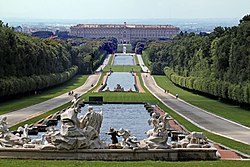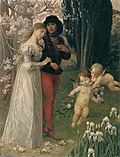Italian nobility

The Italian nobility (
Nobles had a specific legal status and held most of the wealth and various privileges denied to other classes, mainly politicians. In most of the former Italian pre-unification states, it was the only class that had access to high-level government positions. They represented the most distinguished positions of the peninsular nations in addition to the Catholic Church for several centuries. There were varying forms of nobility over time in their respective regions.[1]
From the Medieval Period until the nineteenth century in March 1861, Italy was not a single unified sovereign state. It was a peninsular consisting of several separate kingdoms, duchies, and other minor principalities, with many
Recognition of Italian nobility ceased with the creation of the
History
Pre-unification

Before the
In the 15th, 16th, 17th, and 18th centuries, the Italian peninsular was home to a myriad of noble families that had risen to prominence via
There were also families which had been part of Italian nobility for many decades or even centuries. For example in Rome, writing in the 19th century, Leopold von Ranke recorded:
In the middle of the 17th century there were computed to be fifty noble families in Rome of three hundred years' standing, thirty-five of two hundred, and sixteen of one hundred years. None were permitted to claim a more ancient descent, or were generally traced to an obscure, or even a low origin.
Sicilian nobility

The
The Romans, Byzantines and Saracens exported different elements of their aristocratic structures to the island of Sicily, however, it was not until the Norman invasion of 1061, led by Roger I de Hauteville, that the Sicilian aristocracy and feudal system took root.
Over the centuries, established noble families were advanced through the aristocratic ranks. By the 18th century, the titles
Papal nobility
During this period, throughout Italy various influential families came to positions of power through the election of a family member as Pope or were elevated into the ranks of nobility through ecclesiastical promotion. These families freely intermarried with aristocratic nobility. Like other noble families, those with both papal power and money were able to purchase comunes or other tracts of land and elevate family patriarchs and other relatives to noble titles. Hereditary patriarchs were appointed Duke, Marquis and even Prince of various 16th and 17th century principalities. According to Ranke:
Under
Barberini., The History of the Popes
The period was famous for papal nepotism and many families, such as the Barberini and Pamphili, benefited greatly from having a papal relative. Families that had previously been limited to agricultural or mercantile ventures found themselves, sometimes within only one or two generations, elevated to the Roman nobility when a relative was elected to the papal throne.[2] Modern Italy is dotted with the fruits of their success – various family palazzi stand today as a testament to their sometimes meteoric rise to power.
Genoese nobility
In the case of the Republic of Genoa, through the Constitutional Reform and the laws of 1528, 1548 and 1575, an aristocratic republic was inaugurated, which would last until 1797. With the constitutional reform of 1528, belonging to an albergo became from optional to compulsory, effectively transforming the alberghi into lists of registration to the city nobility recognized by the government. The reform required that the wealthiest citizens who owned six or more houses should originate a distinct albergo. On that occasion, it was decided to establish a single Order of noble citizens, otherwise known as Old Nobles, divided into twenty-three old and already existing alberghi and five new ones were created for the occasion. These associations were to prevent the resurgence of ancient hostilities and protect the wealth and power of the wealthiest families.[3][4]
Florentine nobility

The Florentine, and later Tuscan nobility distinguished itself in the two classes of Patricians, recognized as noble since before 1532, belonging to the Order of Saint Stephen, and residing only in the ancient noble homelands: Florence, Siena, Pisa, Pistoia, Arezzo, Volterra, Montepulciano and Cortona. And of the nobles, simple nobility, civic nobility, senators and commanders, with residence of the "new" noble homelands: Sansepolcro, San Miniato, Livorno, Pescia and Prato. Overall, the Florentine nobility was divided into feudal, senatorial and priority.[5][6]
Milanese nobility
In
Venetian nobility
The Venetian Patriciate was one of the three social bodies into which the society of the Republic of Venice was divided, together with citizens and foreigners. Patrizio was the noble title of the members of the aristocracy ruling the city of Venice and the Republic. The title was abbreviated, in front of the name, by the initials N.H. (Nobil Homo), together with the feminine variant N.D. (Nobildonna). Holding the title of a Venetian patrician was a great honour and many European kings and princes, as well as foreign noble families, are known to have asked for and obtained the prestigious title.
The noble houses were primarily divided into Old (Case vecchie) and New houses (Case nuove), with the former being noted for traditionally electing the first Doge in 697 AD. The New houses were no less significant, as many became very prominent and important in influencing the history of the Republic of Venice. The families were furthermore divided into several other "categories", including Ducal houses (which gave Doges), Newest houses (Case nuovissime), Non-Venetian patricians, and "Houses made for money" (usually very wealthy landowning or bourgeoise families enriched through trade).
Although there were numerous noble houses across Venice's
families.Kingdom of Italy (1861–1946): the House of Savoy
The House of Savoy was the ruling dynasty of the Duchy of Savoy, then the Kingdom of Sardinia and later Kingdom of Italy from 1861 to 1946. The nobility of this House of Savoy masterminded the creation of the Kingdom of Italy.
In the years preceding the political and social movement that resulted in the consolidation of
led to parallel nobilities with different traditions and rules.Unification

Modern Italy became a nation-state during the
Nobility in the Kingdom

Under the united
After the unification of Italy, its kings continued to create titles of nobility for eminent Italians, this time valid for all Italian territory. For example, General
In 1929, the Lateran Treaty acknowledged all Papal titles created before that date and undertook to give unquestioned recognition to titles conferred by the Holy See on Italian citizens in the future.[11]

After the successful Italian
In May 1936 the king
Italian Republic
In 1946, the Kingdom of Italy was replaced by a
Certain predicati (
Titles of nobility

The southern kingdoms of Naples, Sicily, and Sardinia, as well as the Papal states, granted titles as in monarchies such as Spain, France, or England: duke, marquis, count, baron. The title of viscount was not, however, as frequent in Italy as elsewhere. Joseph Bonaparte conferred the title "prince" to be hereditary on his children and grandchildren.[15]
Often, Italian comunes (also in the Kingdom of Naples) and republics granted or recognised the title of Patrician (post-Roman Europe)[16]
The Republic of Venice also granted feudal titles. In the Middle Ages:
The majority of feudatories were simply signori (from the French
seigneur, a title introduced into Italy by the 11th century Normans), vassalli (vassals) or cavalieri (knights). Eventually, this class came to be known collectively as the baroni (barons); in Italy barone was not always a title descriptive of a particular feudal rank. During the 14th century, most minor feudal lands became baronies, their holders barons. It must be observed that the use of these titles usually required some form of sovereign award or feudal tenure.[17][full citation needed]
During the Renaissance, noble families conquered most of the Italian city-states except the republics of Venice, Genoa, Lucca, San Marino and Ragusa.
Until 1806, parts of the present-day Italy formed the Kingdom of Italy, belonging to the Holy Roman Empire. When in 1861 the king of Sardinia annexed the other Italian states, the Consulta Araldica (the Italian college of arms) integrated these different and varied systems into the hierarchy described below.
Ranks

The official ranks under the Kingdom of Italy (1861–1946) were:
| Italian | Translation | ||
|---|---|---|---|
| Masculine | Feminine | Masculine | Feminine |
| Re d'Italia | Regina d'Italia | King of Italy | Queen of Italy
|
| Principe | Principessa | Prince | Princess |
| Duca | Duchessa | Duke | Duchess
|
| Marchese | Marchesa | Marquis
|
Marchioness
|
| Conte | Contessa | Count (Earl) | Countess
|
| Visconte | Viscontessa | Viscount | Viscountess
|
| Barone | Baronessa | Baron | Baroness
|
| Nobile, or Nobiluomo | Nobile, or Nobildonna | Nobleman | Noblewoman |
Cavaliere ereditario
|
Dama | Baronet (hereditary knight) | Dame |
| Patrizio of certain cities | Patrizia of certain cities | Patrician | |
This hierarchy resulted from the overlapping of titles granted by the pre-unification states, though these were different from each other.
Post-World War II
By 1946, with abolition of the monarchy, a number of titles borne by families in the pre-unification states (Two Sicilies, Papal State, etc.) still had not been matriculated by the Consulta Araldica.
Palaces and noble houses
Palaces of rulers


- Palace of Caserta: residence of the king of the Two Sicilies.
- Royal Palace (Naples): residence of the king of the Two Sicilies.
- Royal Palace of Milan: residence used by the King of Italy in Milan.
- Museo di Capodimonte: residence of the king of the Two Sicilies.
- Palazzo dei Normanni: residence of the king of Sicily.
- Residences of the Royal House of Savoy: residences of the king of Italy.
- Ducal Palace of Colorno: residence of the duke of Parma and Piacenza.
- Ducal Palace of Lucca: residence of the duke of Lucca.
- Ducal Palace of Modena: residence of the duke of Modena and Reggio.
- Ducal Palace of Massa: residence of the duke of Massa and Carrara.
- Palazzo Ducale di Mantova: residence of the duke of Mantua.
- Palazzo Ducale di Urbino: residence of the duke of Urbino.
- Palazzo Pitti: residence of the grand duke of Tuscany.
- Castle of Racconigi: residence of the Carignano line of the House of Savoy.
- Royal Palace of Cagliari: official seat of the king of Sardinia in his kingdom, actually used as residence of the viceroy and some other administrative bodies.
Sovereign houses


- House of Savoy: Kings of Italy (1861–1946), Kings of Spain (1870–1873), Emperors of Ethiopia (1936–1941), Kings of Albania (1939–1943), Kings of Croatia (1941–1943), Kings of Sicily (1713–1720), kings of Sardinia (1720–1861), dukes of Savoy (1416–1861), lords and princes of Piedmont (1233–1416), counts of Savoy (1032–1416), marquises of Turin (1057–1233)
- House of IvreaKings of Italy
- House of Habsburg and Habsburg-Lorraine: kings of Italy (1519–1802), kings of Sicily (1720–1734), kings of Sardinia (1708–1720), kings of Naples (1713–1734), kings of Lombardy–Venetia (1815–1859), grand dukes of Tuscany (1737–1801; 1815–1859), dukes of Milan (1535–1797), dukes of Parma and Piacenza; dukes of Mantua (1708–1797)
- House of Hauteville: kings of Sicily (1130–1198), dukes of Apulia (1059–1198), counts of Apulia (1042–1059), counts of Sicily (1071–1130)
- House of Hohenstaufen: kings of Italy (1128–1135; 1154–1197; 1212–1250), kings of Sicily (1198–1266)
- House of Anjou-Capetian: kings of Sicily (1266–1282), kings of Naples (1282–1442)
- House of Barcelona: kings of Sicily (1282–1516), kings of Sardinia (1324–1516), kings of Naples (1442–1516)
- House of Bourbon: dynasty divided into:
- House of Bourbon-Parma: dukes of Parma, Piacenza and Guastalla (1748–1802; 1847–1859), kings of Etruria (1801–1807), dukes of Lucca (1824–1847)
- House of Bourbon-Two Sicilies: kings of Naples (1735–1806; 1815–1816), kings of Sicily (1735–1816), kings of the Two Sicilies (1816–1861)
- House of Bonaparte: king of Italy (1805–1814), king of Rome, king of Naples (1806–1808)
- House of Medici: de facto lords of Florence and Tuscany (1434–1494; 1512–1527), dukes of Florence (1531–1569), grand dukes of Tuscany (1569–1737)
- House of Este: Margraves of Este (1171), lords and marquesses of Ferrara (1240–1471), dukes of Ferrara (1471–1597), dukes of Modena and Reggio (1452–1796), counts of Polesine and Garfagnana
- House of Austria-Este: dukes of Modena and Reggio (1814–1860)
- House of Farnese: dukes of Parma and Piacenza (1545–1731); dukes of Castro
- House of Visconti: lords of Milan and Lombardy (1277–1395), dukes of Milan (1395–1447)
- House of Sforza: dukes of Milan (1450–1499; 1512–1515; 1521–1535)
- House of Gonzaga: lords of Mantua (1328–1433), marquesses of Mantua (1433–1530), dukes of Mantua (1530–1708); marquesses of Montferrat (1536–1574), dukes of Montferrat (1574–1708)
- House of Paleologus: marquesses of Montferrat (1306–1536)
- House of Aleramici: marquesses of Saluzzo (1125–1548), marquesses of Montferrat (before 933–1306)
Papal houses
Duke
Marquesses
Gallery
-
Farinata degli Uberti (1212–1264)
-
Paolo Malatesta, Count of Ghiaggiolo (c. 1246–1285)
-
Cangrande della Scala, Lord of Verona(1291–1329)
-
Toscanella(1350–1421)
-
Braccio da Montone, Lord of Perugia (1368–1424)
-
Sigismondo Pandolfo Malatesta, Lord of Rimini (1417–1468)
-
Lorenzo de' Medici (1449–1492)
-
Duke of Milan(1452–1508)
-
Vitellozzo Vitelli, Lord of Città di Castello (1458–1502)
-
Count Giovanni Pico della Mirandola (1463–1494)
-
Admiral Andrea Doria (1466–1560)
-
Pietro Bembo (1470–1547)
-
Duke of Urbino(1472–1508)
-
Cesare Borgia, Duke of Valentinois (1476–1507)
-
marchioness of Pescara(1490–1547)
-
Sebastiano Venier, Doge of Venice (1496–1578)
-
Lorenzo Cybo, Duke of Ferentillo (1500–1549)
-
Admiral Agostino Barbarigo (1518–1571)
-
Giovanni Luigi Fieschi, Count of Lavagna (1522–1547)
-
Morosina Morosini, Dogaressa of Venice (1545–1614)
-
Duke of Sora(1548–1612)
-
Asdrubale Mattei, Duke of Giove (1556–1638)
-
Charles Emmanuel I, Duke of Savoy (1562–1630)
-
Vincenzo Gonzaga, Duke of Mantua(1562–1612)
-
Cardinal Federico Borromeo (1564–1631)
-
Marchese Vincenzo Giustiniani (1564–1637)
-
Ranuccio I Farnese, Duke of Parma(1569–1622)
-
Admiral Federico Spinola (1571–1603)
-
Livia della Rovere, Duchess of Urbino (1585–1641)
-
Alessandro Spinola, Doge of Genoa (1589–1665)
-
Donna Olimpia Maidalchini (1591–1657)
-
Cardinal Ludovico Ludovisi (1595–1632)
-
Honoré Grimaldi, Prince of Monaco (1597–1662)
-
Ottavio Piccolomini, Duke of Amalfi (1599–1656)
-
Cardinal Francesco Sforza Pallavicino (1607–1667)
-
Count Raimondo Montecuccoli (1609–1680)
-
Count Carlo Rossetti, Cardinal (1614–1681)
-
Cardinal Flavio Chigi, Duke of Ariccia (1631–1693)
-
Princess Anna Maria Mancini (1639–1715)
-
Grand Duke of Tuscany(1642–1723)
-
Cardinal Benedetto Pamphili (1653–1730)
-
Urbano Barberini, Prince of Palestrina (1664–1722)
-
Count Giacomo Durazzo (1717–1794)
-
Pope Pius VI (Count Giovanni Angelo Braschi) (1717–1799)
-
Ludovico Manin, 120th and last Doge of Venice (1725–1802)
-
Maria Teresa Felicitas d'Este (1726–1754)
-
Cardinal Giuseppe Albani (1750–1834)
-
Anna Pieri Brignole Sale (1765–1815)
-
Count Giacomo Leopardi (1798–1837)
-
Camillo Benso, Count of Cavour (1810–1861)
-
Giuseppe Tomasi, 11th Prince of Lampedusa (1896–1957)
-
Fulco Santostefano della Cerda, Duke of Verdura (1898–1978)
-
Prince Aimone, Duke of Aosta (1900–1948)
See also
- Consulta araldica
- Corpo della Nobiltà Italiana
- Libro d'Oro
- Annuario della Nobiltà Italiana
References
- ^ Visconti, Alessandro. (1958). L'Italia nell'epoca della Controriforma 1516-1713 (in Italian). Mondadori.
- ^ a b c History of the popes; their church and state (Volume III) by Leopold von Ranke (2009, Wellesley College Library)
- ^ "ALBERGO dei nobili in "Enciclopedia Italiana"". www.treccani.it (in Italian). Retrieved 2020-09-30.
- ^ "albergo in "Dizionario di Storia"". www.treccani.it (in Italian). Retrieved 2020-09-30.
- ^ "Famiglie fiorentine iscrite nei libri della nobilta'". www.carnesecchi.eu. Retrieved 2020-09-30.
- ^ Ammirato, Scipione. Delle Famiglie Nobili Fiorentine di Scipione Ammirato, Vol. 1 (in Italian). Forgotten Books.
- ^ Visconti, Katia. Il commercio dell'onore. Un'indagine prosopografica della feudalità nel milanese di età moderna (in Italian). CUEM.
- ^ AB (May 2020). "Famiglia Loredano | Conoscere Venezia" (in Italian). Retrieved 2021-08-04.
- ^ "Il Palazzo". Reggia di Caserta Unofficial (in Italian). 14 October 2016.
- ISBN 9782259222679– via Google Books.
- ^ a b Guy Stair Sainty Archived November 20, 2010, at the Wayback Machine
- ^ Indro Montanelli, Mario Cervi, Storia d'italia. L'Italia della guerra civile, RCS, 2003
- ^ "How Professional Genealogists Determine Ancestral Nobility in Italy". Italiangenealogy.com. 24 October 2015. Retrieved 2016-08-11.
- ^ Kretschmer, A. (4 October 2019). "Princess Beatrice revelation: Heartbreaking reason why Edo cannot take aristocratic title". UK Daily Express. Retrieved 15 October 2019.
They (Italian titles) may still be used as a courtesy, but have no legal standing (in the UK).
- ^ Velde, François. "Titles of Nobility". Heraldica.org. Retrieved 25 March 2021.
- ^ https://www.docenti.unina.it/webdocenti-be/allegati/materiale-didattico/34330813%7Ctitle=Ancora da Marc Bloch, La società feudale|access-date=16 December 2023|language=it|page=3
- ^ Italian Titles of Nobility
External links
- Sicilian Nobility Listings
- Southern Italy Nobility Listings Archived 31 August 2007 at the Wayback Machine
- Nobiliary and Aristocratic History Archived 2007-08-16 at the Wayback Machine
- European Royal Houses
- Castles in Italy: the medieval life of noble families (Clemente Manenti)
- Il Corpo della Nobiltà Italiana

























































